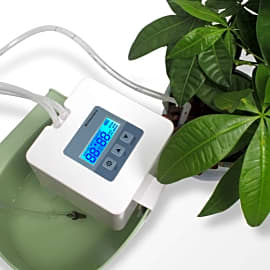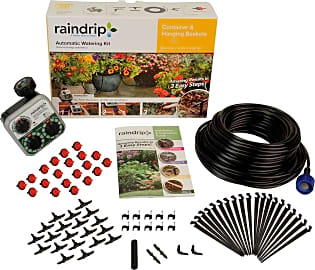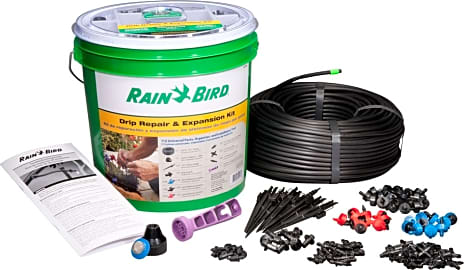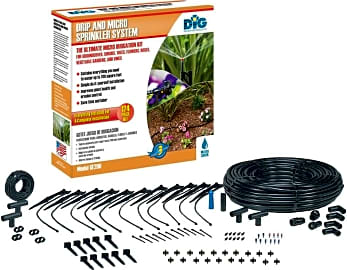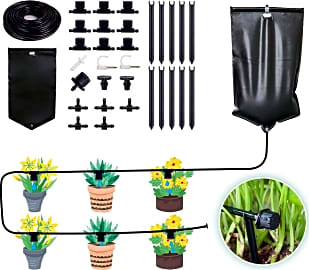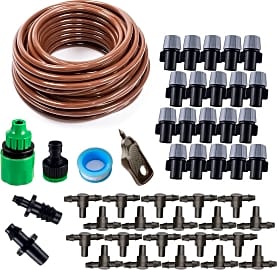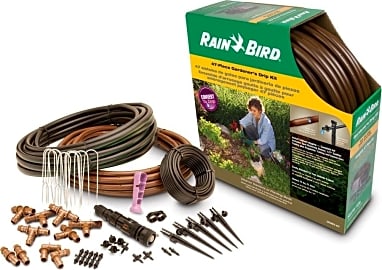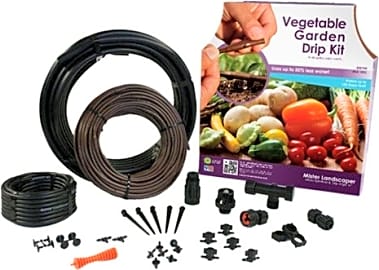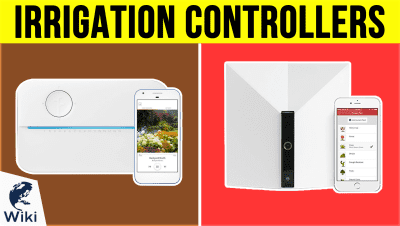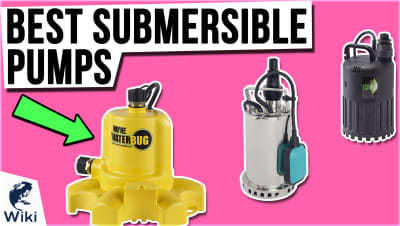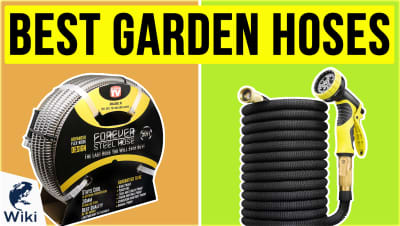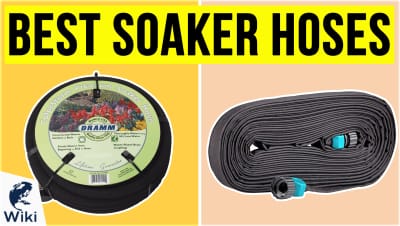The 10 Best Drip Irrigation Kits

This wiki has been updated 36 times since it was first published in October of 2016. If you live in a region that doesn't get much rainfall, or you tend to forget to water your plants, one of these drip irrigation kits can solve your problem quickly and efficiently by automating the process. We've included several options well suited to outdoor planters and flowerbeds, as well as some picks that make more sense for indoor applications, like plant stands. When users buy our independently chosen editorial selections, we may earn commissions to help fund the Wiki.
Editor's Notes
September 17, 2020:
During this round of updates, while the majority of our previous picks still seemed to present options well worth considering for many of our users, we did decide on doing away with the Agsivo Self-Plant, noting some availability issues with the offering. We also eliminated the Orbit 69525 – recognizing that its selection of fittings was rather sparse – as well as the Orbit 69500 — which doesn’t include any hoses or tubing. The 69500 – which was lauded in a September 13, 2019 editor’s note on this page, for its excellent value – does, in fact, remain an excellent supplementary selection for users looking to modify or expand on an existing kit, but without the inclusion of any hoses, I felt that it was difficult to declare it one of the best kits in its own right. In practice, the combination of the 69500 and 69525 would actually make for a versatile, and still reasonably affordable, package. But, in the interest of creating some space for incoming new inclusions, we felt that it made sense to remove them.
Our new additions this time around are the HydroLock Covered — a good option for indoor gardens, that favors a submersible pump in lieu of a garden hose; the Moistenland Gen 4 — a light-duty model that combines a pump and timer into a single housing; and the Padram Water Bag — which uses gravity to slow feed up to 10 plants throughout the day.
A few things to think about for this category:
Supply: Something I noticed right away with these rankings was that, previously, we were exclusively ranking kits geared toward outdoor gardens – ones that hook up to your lawn service, that may be prone to a reasonable margin of leakage and are generally intended to service a fairly large area. There’s nothing wrong with these kits. They’re great (although a soaker hose often works just as well), especially for users in warm climates, who don’t need to worry about their plastic components rupturing through the winter. But at the same time, it did feel as if we were doing a disservice to our indoor-gardening users, who would like a drip system that doesn’t depend on a garden hose.
With that in mind, all three of our new rankings are non-garden-hose offerings, suitable for indoor use. The HydroLock Covered and Moistenland Gen 4 both include pumps, while the Padram Water Bag is gravity powered. In addition to being an asset to users without easy hose access, these offerings have the benefit of drawing from a reservoir, providing an easy means for users to introduce chemical or organic fertilizers to their plants. Note, however, that granular plant food may be problematic when it comes to feeding through these thin lines.
Control: The Padram Water Bag is the only option we listed that doesn’t need to be manually operated in the absence of a timer, and the Moistenland Gen 4 and Raindrip R560DP Automatic are the only options we listed that come with timers. For all other hose-powered selections, you’ll likely want to consider investing in a hose timer, and for any pump-powered models, an outlet timer is recommended.
Installation: Normally, this is the consideration in the editor’s note where I warn you that you might need to call a professional for this. But, in this case, providing you’re a reasonably competent DIYer, I’m actually quite sure you’ll be able to get the job done. (Tip: Try using hot water to give your tubing a bit of elasticity, if you’re having trouble getting a fitting to fit.) However, I will still urge you to put some advance thought into installation, to ensure that the kit you’re considering has enough fittings to properly outfit your garden. If you can’t find one that does, you may want to consider ordering a supplementary set of fittings; perhaps you’ll be interested in the Orbit 69500.
September 13, 2019:
It's important to realize that you'll almost certainly have to perform periodic maintenance and upkeep on any system you install, regardless of its quality. That's why the Orbit 69500 ranked so highly on this list, because while it's an impressive kit in its own right, it's incredibly useful for patching up any system you install. The low price point makes it a worthwhile purchase even if you decide to buy another kit to serve as your primary unit.
If you need to expand an existing system, it's hard to beat the Rain Bird Expansion. It comes with a massive amount of universal tools, allowing you to create an efficient watering system out of a mess of patchwork parts.
Note that, while many of these can be simply hooked up to a faucet that you can turn on and off at your leisure, you may want to automate the process by investing in an irrigation controller. These systems allow you to determine exactly how much water your plants get, and when. They're helpful for reducing waste, not to mention reducing the risk that you'll forget for a few days, killing your plants in the process.
Special Honors
Drip Depot Ultimate This kit is ideal for large-scale backyard watering operations, as it can service up to 10 raised beds simultaneously. It's also easy to modify if you find you need to irrigate even more than that. dripdepot.com
DripWorks Row Crop Kit With 2,000 feet of drip tape and a PSI regulator, this model can water an eighth of an acre without failing or flooding. While it's not automatic out of the box, you can easily make it so by adding a timer to it. dripworks.com
Gator Drip Kit This system has everything you need to get set up in a hurry, including two separate thousand-foot spools of drip tubing. Perfect for commercial applications, it delivers the water in a stream targeted at the plant's roots, with little waste. agrisupply.com
A Brief History Of Irrigation
Most of these early irrigation systems involved simply manipulating the existing flow of water, and as such, they limited the areas in which civilization could flourish.
When you think about the inventions and innovations that made modern civilization possible, you probably overlook irrigation. Sure, fire and the wheel are nice, but the ability to reliably grow and maintain crops almost single-handedly transformed humanity from nomadic tribes of hunter-gatherers to stable, established communities.
The first evidence of irrigation comes from 4500 B.C.E. in the Indus Valley, near modern-day Pakistan. The people in this region built artificial reservoirs to trap rainwater, which they then transported to their crops via canals. This allowed for a huge increase in the amount of food produced in the region — and, as a result, the amount of people the region could support.
A few millennia later, the Egyptians used the flooding of the Nile to trap water in plots of land surrounded by dykes. This allowed for perennial irrigation, enabling farmers to reliably and predictably water their crops, rather than just coax them through a dry spell.
Meanwhile, across the pond, tribes in the Andes Valley of Peru pioneered the use of terrace irrigation, which transformed mountainsides into steps that water would gradually flow down. Farmers were thus able to grow rice, potatoes, maize, and more in what would otherwise have been treacherous terrain.
Most of these early irrigation systems involved simply manipulating the existing flow of water, and as such, they limited the areas in which civilization could flourish. However, beginning around the 6th century B.C.E., the Chinese began to experiment with hydraulics to manipulate the course of rivers. Chain pumps and waterwheels were built, allowing farmland to stretch across the entire country.
Today, modern irrigation is a fascinating mix of the new and the old, as some of the most primitive techniques — such as siphoning off a river to flood a plain — are still in widespread use, while more advanced approaches like sprinklers and drip irrigation allow for everything from sensitive crops to public parks to thrive. In fact, some areas even water plants from the roots up, raising water tables and reducing evaporation, while others use drones to ensure pinpoint-accuracy when it comes to watering properly.
Time will tell where we go from here, but it's likely that future innovations in irrigation will involve reducing waste and limiting erosion. After all, just because we can get water to go wherever we want it to doesn't mean we should put it wherever we can.
Benefits Of A Drip Irrigation System
For many people, a drip irrigation system is the best and most cost-effective way to ensure that their lawn or garden stays healthy and fertile as long as possible.
The reason why they can save you money is because they don't use as much water as many other watering systems. Because they deliver water straight to the root of the plant, rather than dispersing it over a wide area, there's less waste without depriving your precious plants of juice.
You'll also encounter fewer weeds when you use a drip system, as virtually all the water you use will be soaked up by your plants.
The systems are also easier to customize to your particular situation. Most layouts use extremely flexible hosing that you can snake around obstacles, allowing you to be absolutely certain that you don't miss a single plant.
That also reduces the need to alter your landscape. You don't need to level out your lawn, or move any tree stumps or fence posts that might be in your way. It's an extremely low-effort solution, even when factoring in installation.
You'll also encounter fewer weeds when you use a drip system, as virtually all the water you use will be soaked up by your plants. There won't be large patches of wet, fertile ground for crabgrass or dandelions to sprout up, reducing the amount of time you have to spend outside with your hoe.
Drip systems aren't all sunshine and rainbows, however. You will pay a little more up-front to install one, and the sun could damage the tubes over time. Additionally, basic periodic maintenance will likely be required to ensure that nothing gets clogged.
All in all, though, you'll likely find that keeping a lush, green garden is much easier (and friendlier to your wallet in the long run) with a drip system installed.
Tips For Getting The Most Out Of Your Drip Irrigation System
Once you've made the decision to convert your landscaping over to a drip irrigation system, there are a few things to keep in mind to ensure that everything goes as smoothly as possible.
Before you get started, you need to plan out the system and examine your terrain. Remember that pushing water uphill requires more pressure, and you'll want to be sure that you'll have enough to sufficiently water any plants in high terrain.
Remember that pushing water uphill requires more pressure, and you'll want to be sure that you'll have enough to sufficiently water any plants in high terrain.
Decide if you're planning on automating your entire operation, as well. Obviously, if you do, you'll need to invest in a quality timer, but that can save you a massive amount of time and frustration down the line, and isn't that the whole point of installing one of these things?
You also need to be able to look into the future a little bit. Are your plants going to get bigger and require more water? Will you be expanding your lawn or garden, and need a system that can easily be extended? While it's not essential to answer these questions before you begin, doing so can certainly prevent frustration later on.
Be sure to soak your emitters in a vinegar and water solution every now and then to prevent magnesium or calcium build-ups. If not, the system could get clogged — and your plants could get under-watered.
The good thing about these systems is that, as long as you install them correctly and don't let them fall into disrepair, they're pretty hard to screw up, so you shouldn't need to do much to get the most out of yours.
Just make sure the wet stuff falls on the green stuff.



